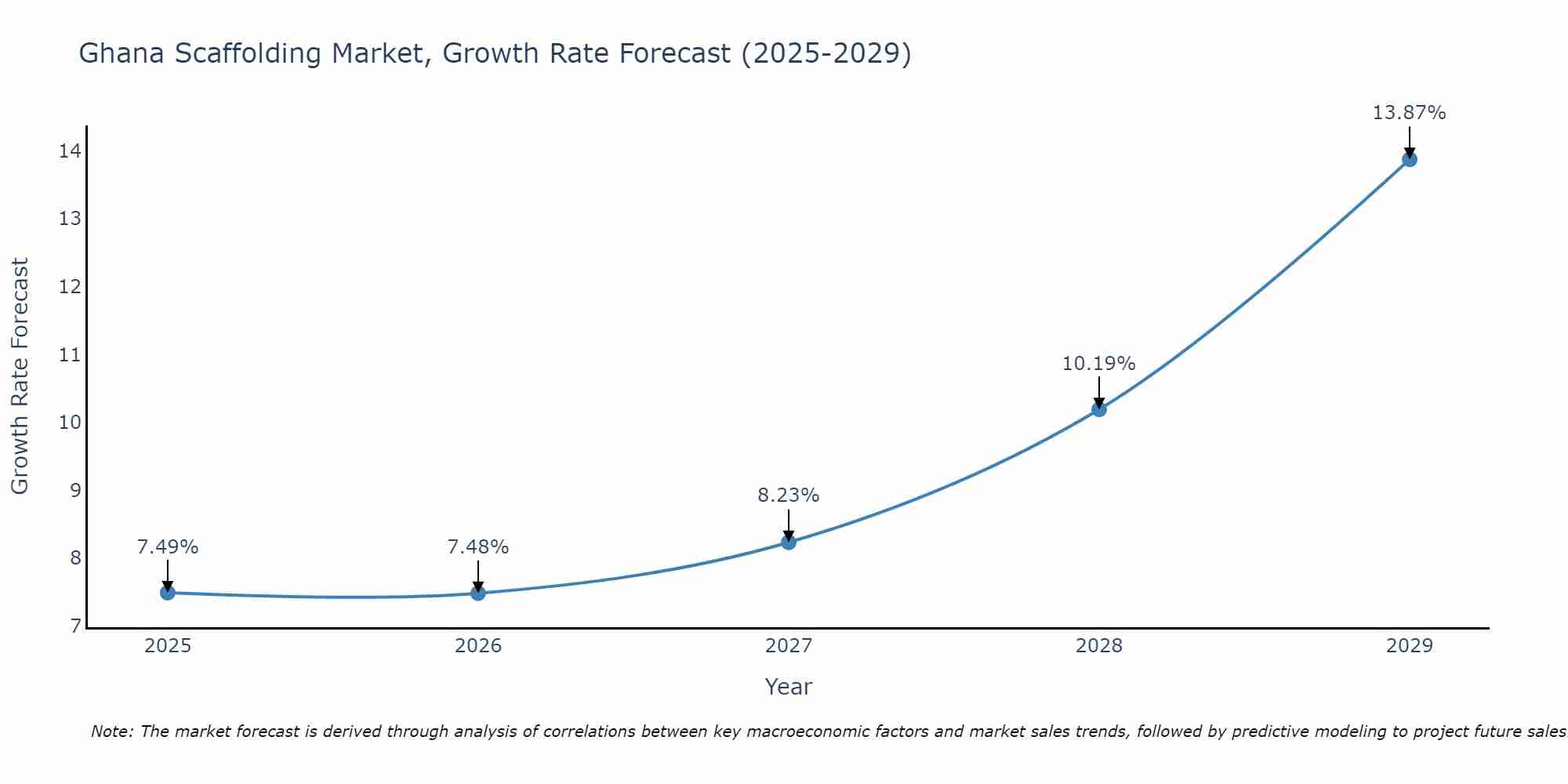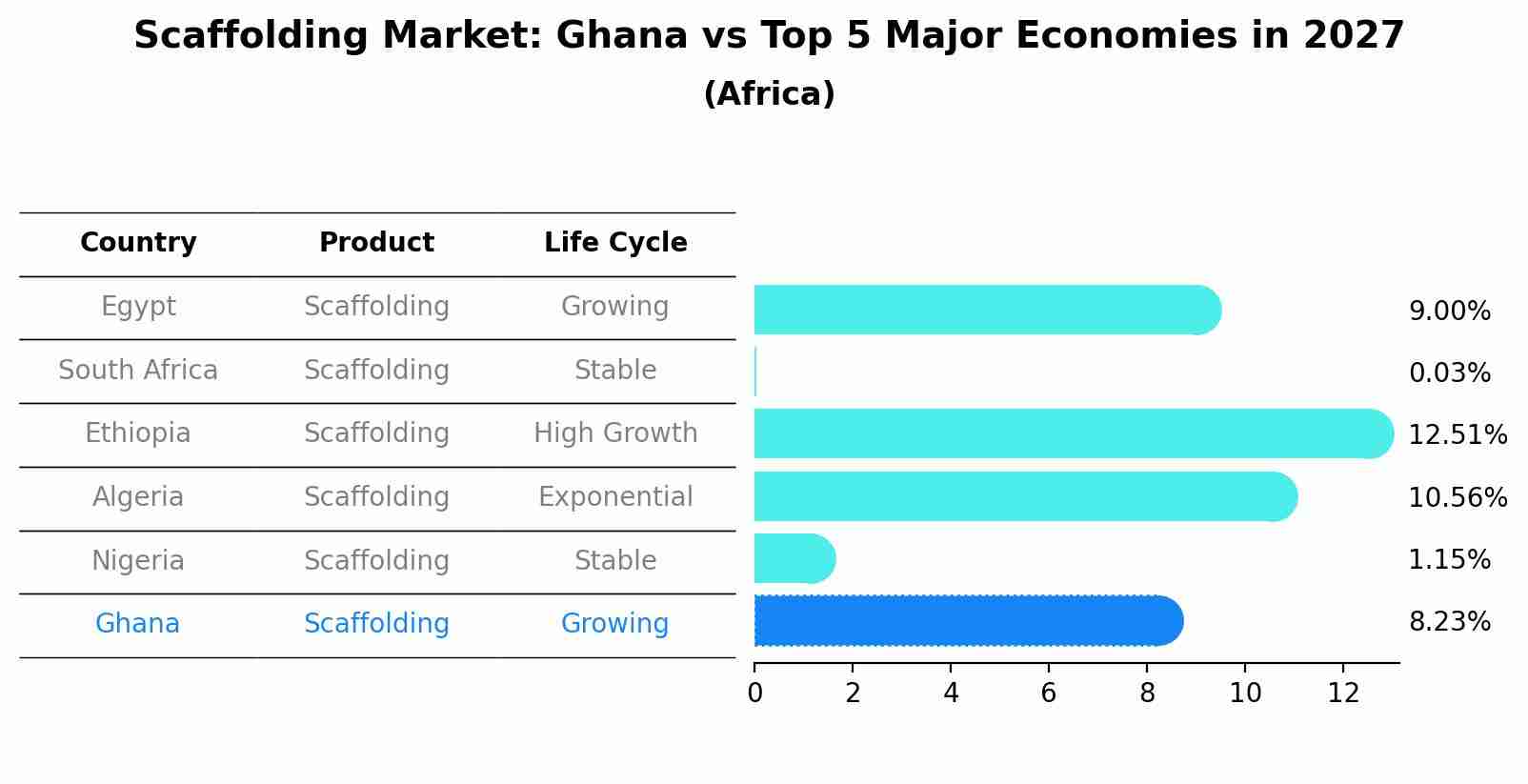Ghana Scaffolding Market (2025-2031) Outlook | Share, Companies, Value, Analysis, Trends, Size, Forecast, Industry, Growth & Revenue
| Product Code: ETC377816 | Publication Date: Aug 2022 | Updated Date: Jul 2025 | Product Type: Market Research Report | |
| Publisher: 6Wresearch | Author: Dhaval Chaurasia | No. of Pages: 75 | No. of Figures: 35 | No. of Tables: 20 |
Ghana Scaffolding Market Size Growth Rate
The Ghana Scaffolding Market is projected to witness mixed growth rate patterns during 2025 to 2029. From 7.49% in 2025, the growth rate steadily ascends to 13.87% in 2029.

Scaffolding Market: Ghana vs Top 5 Major Economies in 2027 (Africa)
By 2027, Ghana's Scaffolding market is forecasted to achieve a growing growth rate of 8.23%, with Egypt leading the Africa region, followed by South Africa, Ethiopia, Algeria and Nigeria.

Ghana Scaffolding Market Synopsis
The Ghana scaffolding market is experiencing steady growth due to the expansion of construction and infrastructure projects in the country. The demand for scaffolding equipment is driven by the increasing number of high-rise buildings, commercial complexes, and industrial facilities being constructed in urban areas. The market is characterized by a mix of local and international scaffolding companies offering a range of products and services to meet the diverse needs of construction projects. Key factors influencing market growth include government investments in infrastructure development, urbanization trends, and the growing emphasis on safety standards in the construction industry. Overall, the Ghana scaffolding market presents opportunities for growth and innovation as stakeholders focus on enhancing efficiency, safety, and sustainability in construction practices.
Ghana Scaffolding Market Trends
The Ghana scaffolding market is experiencing growth driven by increasing construction activities in both residential and commercial sectors. The demand for versatile and durable scaffolding solutions is on the rise, leading to a trend of innovative and lightweight scaffold designs that offer ease of assembly and enhanced safety features. Additionally, there is a growing focus on eco-friendly scaffolding materials and practices to align with sustainability goals. Market players are also investing in technology-driven solutions such as digital monitoring systems for improved efficiency and safety on construction sites. Overall, the Ghana scaffolding market is witnessing a shift towards advanced, user-friendly, and sustainable solutions to meet the evolving needs of the construction industry.
Ghana Scaffolding Market Challenges
In the Ghanaian scaffolding market, challenges include the lack of standardized regulations and enforcement, leading to safety concerns and inconsistent quality across providers. Limited access to skilled labor for proper installation and dismantling of scaffolding structures also hinders the market`s growth. Additionally, the high cost of importing quality scaffolding materials and equipment due to currency fluctuations and import duties poses a financial challenge for both suppliers and buyers. Lack of awareness among construction firms and contractors about the benefits of using quality scaffolding solutions further impedes market expansion. Addressing these challenges through improved regulations, training programs, and promotion of safety standards can help drive growth in the Ghana scaffolding market.
Ghana Scaffolding Market Investment Opportunities
The Ghana scaffolding market presents promising investment opportunities due to the country`s growing construction industry fueled by infrastructure development projects. With a focus on safety regulations and quality standards, there is a demand for modern and efficient scaffolding solutions. Investors can explore opportunities in providing innovative and sustainable scaffolding products and services, such as lightweight and easy-to-assemble systems, adjustable scaffolding designs to suit various project requirements, and rental services to cater to the fluctuating demand in the market. Additionally, offering training programs for workers on scaffolding safety practices can also be a lucrative investment opportunity in Ghana`s scaffolding market. As the construction sector continues to expand, investing in the scaffolding industry can yield long-term returns and contribute to the country`s overall infrastructure development.
Jordan Agar Market Government Policies
The government of Ghana has implemented various policies related to the scaffolding market to ensure safety standards and quality control. The Building Code of Ghana outlines specific regulations for the use of scaffolding in construction projects, emphasizing the importance of proper installation, inspection, and maintenance to prevent accidents. Additionally, the Factories, Offices, and Shops Act mandates that employers provide safe working conditions, including the use of secure scaffolding structures for workers at height. Moreover, the Occupational Health and Safety Act requires companies to conduct risk assessments and provide training for workers using scaffolding equipment. These policies aim to promote a culture of safety and compliance within the Ghana scaffolding market to protect workers and reduce the risk of accidents and injuries.
Ghana Scaffolding Market Future Outlook
The future outlook for the Ghana Scaffolding Market appears promising due to the country`s growing construction industry and infrastructure development projects. With increasing urbanization and a focus on modernizing existing structures, there is a rising demand for scaffolding solutions to support construction activities. Additionally, the government`s commitment to improving the business environment and attracting foreign investments is expected to further drive growth in the construction sector, subsequently boosting the demand for scaffolding products. As safety regulations become more stringent in Ghana, there will be a greater emphasis on utilizing high-quality and reliable scaffolding systems, presenting opportunities for both local and international scaffolding companies to expand their presence in the market.
Key Highlights of the Report:
- Ghana Scaffolding Market Outlook
- Market Size of Ghana Scaffolding Market, 2024
- Forecast of Ghana Scaffolding Market, 2031
- Historical Data and Forecast of Ghana Scaffolding Revenues & Volume for the Period 2021 - 2031
- Ghana Scaffolding Market Trend Evolution
- Ghana Scaffolding Market Drivers and Challenges
- Ghana Scaffolding Price Trends
- Ghana Scaffolding Porter's Five Forces
- Ghana Scaffolding Industry Life Cycle
- Historical Data and Forecast of Ghana Scaffolding Market Revenues & Volume By Type for the Period 2021 - 2031
- Historical Data and Forecast of Ghana Scaffolding Market Revenues & Volume By Supported Scaffolding for the Period 2021 - 2031
- Historical Data and Forecast of Ghana Scaffolding Market Revenues & Volume By Suspended Scaffolding for the Period 2021 - 2031
- Historical Data and Forecast of Ghana Scaffolding Market Revenues & Volume By Rolling Scaffolding for the Period 2021 - 2031
- Historical Data and Forecast of Ghana Scaffolding Market Revenues & Volume By Material for the Period 2021 - 2031
- Historical Data and Forecast of Ghana Scaffolding Market Revenues & Volume By Aluminum for the Period 2021 - 2031
- Historical Data and Forecast of Ghana Scaffolding Market Revenues & Volume By Wood for the Period 2021 - 2031
- Historical Data and Forecast of Ghana Scaffolding Market Revenues & Volume By Steel for the Period 2021 - 2031
- Historical Data and Forecast of Ghana Scaffolding Market Revenues & Volume By End User for the Period 2021 - 2031
- Historical Data and Forecast of Ghana Scaffolding Market Revenues & Volume By Residential for the Period 2021 - 2031
- Historical Data and Forecast of Ghana Scaffolding Market Revenues & Volume By Commercial for the Period 2021 - 2031
- Historical Data and Forecast of Ghana Scaffolding Market Revenues & Volume By Industrial for the Period 2021 - 2031
- Ghana Scaffolding Import Export Trade Statistics
- Market Opportunity Assessment By Type
- Market Opportunity Assessment By Material
- Market Opportunity Assessment By End User
- Ghana Scaffolding Top Companies Market Share
- Ghana Scaffolding Competitive Benchmarking By Technical and Operational Parameters
- Ghana Scaffolding Company Profiles
- Ghana Scaffolding Key Strategic Recommendations
Frequently Asked Questions About the Market Study (FAQs):
- Single User License$ 1,995
- Department License$ 2,400
- Site License$ 3,120
- Global License$ 3,795
Search
Thought Leadership and Analyst Meet
Our Clients
Related Reports
- Canada Oil and Gas Market (2026-2032) | Share, Segmentation, Value, Industry, Trends, Forecast, Analysis, Size & Revenue, Growth, Competitive Landscape, Outlook, Companies
- Germany Breakfast Food Market (2026-2032) | Industry, Share, Growth, Size, Companies, Value, Analysis, Revenue, Trends, Forecast & Outlook
- Australia Briquette Market (2025-2031) | Growth, Size, Revenue, Forecast, Analysis, Trends, Value, Share, Industry & Companies
- Vietnam System Integrator Market (2025-2031) | Size, Companies, Analysis, Industry, Value, Forecast, Growth, Trends, Revenue & Share
- ASEAN and Thailand Brain Health Supplements Market (2025-2031) | Strategy, Consumer Insights, Analysis, Investment Trends, Opportunities, Growth, Size, Share, Industry, Revenue, Segments, Value, Segmentation, Supply, Forecast, Restraints, Outlook, Competition, Drivers, Trends, Demand, Pricing Analysis, Competitive, Strategic Insights, Companies, Challenges
- ASEAN Bearings Market (2025-2031) | Strategy, Consumer Insights, Analysis, Investment Trends, Opportunities, Growth, Size, Share, Industry, Revenue, Segments, Value, Segmentation, Supply, Forecast, Restraints, Outlook, Competition, Drivers, Trends, Demand, Pricing Analysis, Competitive, Strategic Insights, Companies, Challenges
- Europe Flooring Market (2025-2031) | Outlook, Share, Industry, Trends, Forecast, Companies, Revenue, Size, Analysis, Growth & Value
- Saudi Arabia Manlift Market (2025-2031) | Outlook, Size, Growth, Trends, Companies, Industry, Revenue, Value, Share, Forecast & Analysis
- Uganda Excavator, Crane, and Wheel Loaders Market (2025-2031) | Strategy, Consumer Insights, Analysis, Investment Trends, Opportunities, Growth, Size, Share, Industry, Revenue, Segments, Value, Segmentation, Supply, Forecast, Restraints, Outlook, Competition, Drivers, Trends, Demand, Pricing Analysis, Competitive, Strategic Insights, Companies, Challenges
- Rwanda Excavator, Crane, and Wheel Loaders Market (2025-2031) | Strategy, Consumer Insights, Analysis, Investment Trends, Opportunities, Growth, Size, Share, Industry, Revenue, Segments, Value, Segmentation, Supply, Forecast, Restraints, Outlook, Competition, Drivers, Trends, Demand, Pricing Analysis, Competitive, Strategic Insights, Companies, Challenges
Industry Events and Analyst Meet
Whitepaper
- Middle East & Africa Commercial Security Market Click here to view more.
- Middle East & Africa Fire Safety Systems & Equipment Market Click here to view more.
- GCC Drone Market Click here to view more.
- Middle East Lighting Fixture Market Click here to view more.
- GCC Physical & Perimeter Security Market Click here to view more.
6WResearch In News
- Doha a strategic location for EV manufacturing hub: IPA Qatar
- Demand for luxury TVs surging in the GCC, says Samsung
- Empowering Growth: The Thriving Journey of Bangladesh’s Cable Industry
- Demand for luxury TVs surging in the GCC, says Samsung
- Video call with a traditional healer? Once unthinkable, it’s now common in South Africa
- Intelligent Buildings To Smooth GCC’s Path To Net Zero


















